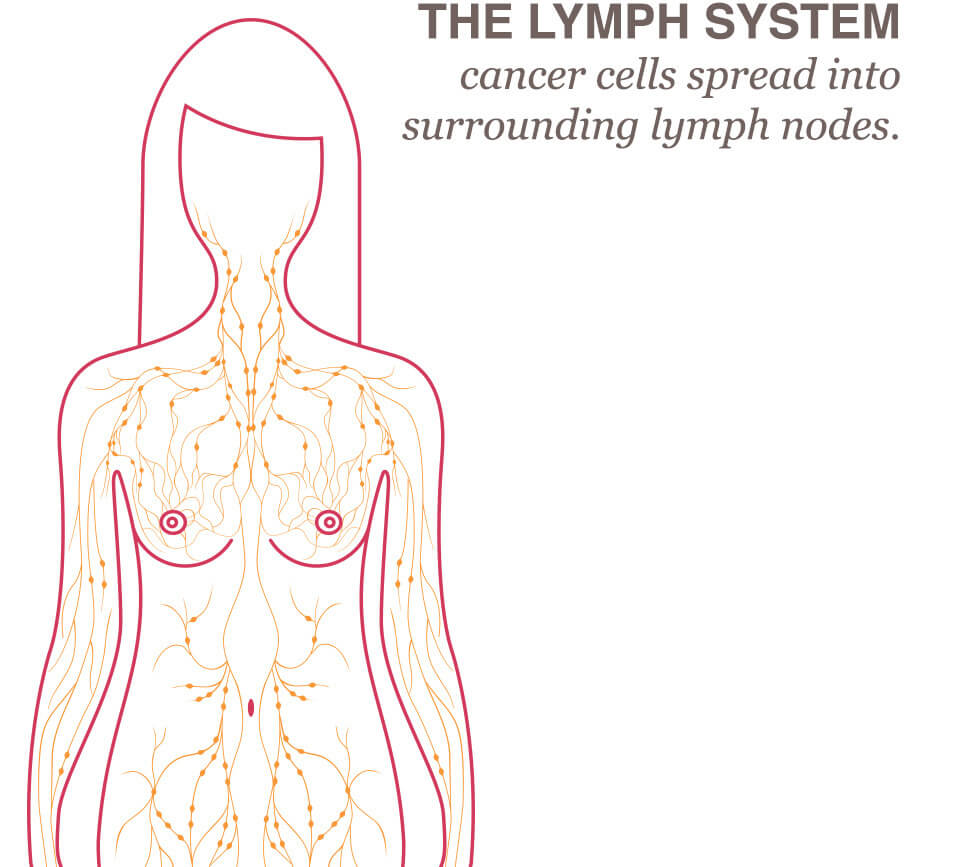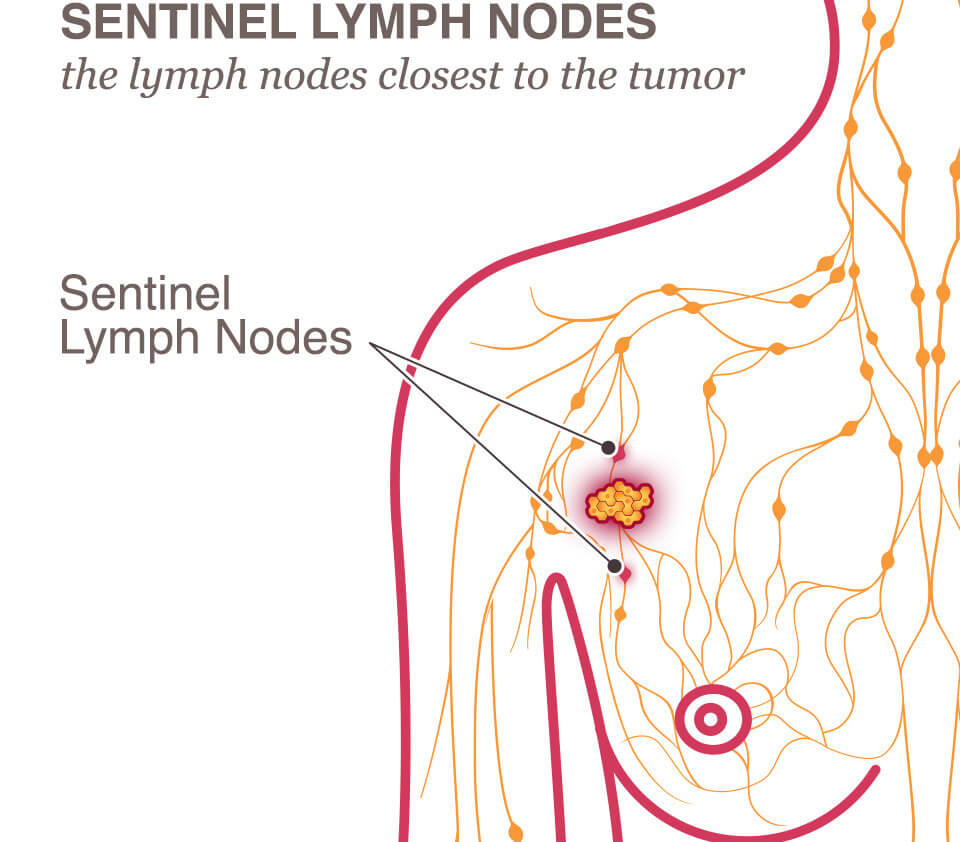Lymph Node Removal & Lymphedema
In addition to your surgical procedure, such as a lumpectomy or mastectomy, your doctor may need to remove and examine lymph nodes to determine whether the cancer has spread and to what extent. Your doctor will use one of two procedures for this, either a sentinel lymph node biopsy/removal or an axillary node dissection. We’ll define these terms below.
How Does The Lymph System Relate To Breast Cancer?

Although breast cancer is not easily controlled, the spread of breast cancer is sometimes predictable. The cancer cells spread through a customary path, out from the tumor and into the surrounding lymph nodes, before they progress throughout the body.
What is the sentinel node?
The sentinel lymph node (and in some cases there are several grouped together) is the first node “downstream” from the cancer in the lymph circulatory system. If the cancer were to travel away from the breast tumor and into the lymphatic system, this node would be the first one to show evidence of breast cancer.
What Is A Sentinel Node Biopsy?
A sentinel lymph node biopsy is a procedure to examine the lymph node closest to the tumor because this is where the cancer cells have most likely spread. First, the surgeon will want to identify the “sentinel lymph node,” the lymph node (or nodes) closest to the tumor. To be able to identify the sentinel lymph node, the surgeon will inject dye or radioactive substances into the tissue near the tumor. The lymph nodes that are the most susceptible to the cancer’s spread will be marked by the dye or radioactive substance. During surgery, the nearest lymph nodes will be removed and checked for the presence of cancer cells.

A biopsy is nearly always taken of the sentinel node, and the breast surgeon typically removes the sentinel node as well for dissection.
What Is An Axillary Node Dissection?
This procedure is a method for determining if the cancer has spread to more than one of your lymph nodes. Axillary node dissection removes some of the the axillary lymph nodes, which are the lymph nodes located in the underarm. Once removed, they are dissected and examined by the pathologist, looking at all of the tissue and individual nodes very closely under a microscope.
Do The Lymph Nodes Always Need To Be Removed?
Not always, especially when there is no evidence of any cancer in the lymph system. A mastectomy or lumpectomy operation will most often include either a sentinel node biopsy or an axillary node dissection. Both procedures involve a separate incision for lumpectomy patients. Following surgery, the pathologist will test the lymph nodes to determine whether the cancer has spread past the breast. When some evidence of cancer is found in the lymph system, recents standards are as follows:
For patients who are having a lumpectomy and the sentinel node is positive for cancer:
Effective in mid-2012, the standard of care was changed to no longer require women with early-stage breast cancers to have a full dissection and removal of the lymph nodes under the arm when the sentinel node is found to contain cancer. Radiation to the underarm area and upper chest wall is also part of treatment. The exception is for postmenopausal patients who are over age 70 and whose cancer is estrogen receptor-positive. These patients may not need radiation and may undergo hormone therapy instead.
For patients who are having a mastectomy surgery and have a positive sentinel node:
For these women, the standard of care remains the same, calling for the node removal and dissection of the axillary (or underarm) nodes. The additional nodes removed at the time of the breast cancer surgery will be examined by the pathologist in the following days to determine if others beyond the sentinel node contained cancer or not. If cancer cells are found in those lymph nodes, other cancer treatments will be considered.
Breast Cancer Surgery: What You Need to Know
Learn more about breast cancer surgery, including lymph node removal, in the free guide.
Breast Cancer Surgery eBookWhat Is Lymphedema?
Lymphedema is a chronic condition that is caused by a disruption or damage to the normal drainage pattern in the lymph nodes. It most often causes swelling of the arm, but it can also affect the breast, chest, and sometimes even the legs. The swelling, caused by an abnormal collection of too much fluid, is called lymphedema. Removing the axillary lymph nodes increases your risk for developing lymphedema.
The risk of developing lymphedema continues for the rest of your life, so it is imperative that you are aware of these risks. Often it is best to learn about preventative measures for lymphedema before surgery so you will know the signs and symptoms to look for and can discuss treatment options with your physician.
Some ways to reduce the risk of developing lymphedema following a lymph node surgical removal or radiation to the lymph node area under the arm are:
- Avoid wearing tight rings, watches, or other jewelry on the affected arm
- No needle sticks or blood pressures should be taken on the affected arm
- Whenever a minor injury such as a small cut of the finger or arm occurs, immediately wash the area, apply antibiotic ointment, and cover with a bandage.
After lymph node surgery, if you experience unusual and painful swelling, you should immediately notify your doctor to monitor it. There is no cure for lymphedema, but your doctor can take steps to reduce swelling and maintain that reduction. With proper health care, good nutrition, and exercise, it may be possible for you to reduce the effects of lymphedema.



